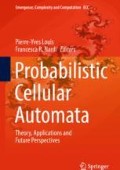Abstract
In the last decades, models inspired by statistical mechanics have been vastly used in the context of social sciences to model the behavior of interacting economic actors. In particular, parallel updating models such as Probabilistic Cellular Automata have been proved to be very useful to represent rational agents aiming at maximize their utility in the presence of social externalities. What PCA do not account for is strategic interaction, i.e., the fact that, when deciding, agents forecast the action of other agents. In this contribution, we compare models that differ in the presence of strategic interaction and memory of past actions. We will show that the emergent equilibria can be very different: Fixed points, cycles of period 2, and chaotic behavior may appear and, possibly, coexist for some values of the parameters, of the model.
References
Bouchaud, J.P.: Crises and collective socio-economic phenomena: simple models and challenges. J. Stat. Phys. 151, 567–606 (2013)
Brock, W.A., Durlauf, S.N.: Discrete choice with social interactions. Rev. Econ. Stud. 68, 235–260 (2001)
Dai Pra, P., Sartori, E., Tolotti, M.: Strategic interaction in trend-driven dynamics. J. Stat. Phys. 152, 724–741 (2013)
Dai Pra, P., Scoppola, B., Scoppola, E.: Sampling from a Gibbs measure with pair interaction by means of PCA. J. Stat. Phys. 149, 722–737 (2012)
Fudenberg, D.: The Theory of Learning in Games, vol. 2. MIT Press, Cambridge (1998)
Landman, K.A., Binder, B.J., Newgreen, D.F.: Modeling development and disease in our “Second” brain. Cellular Automata, pp. 405–414. Springer, Berlin (2012)
Lämmer, S., Helbing, D.: Self-control of traffic lights and vehicle flows in urban road networks. J. Stat. Mech. Theory Exp. 2008, P04019 (2012)
Myerson, R.B.: Game Theory. Harvard University Press, Cambridge (2013)
Piccoli, B., Tosin, A.: Time-evolving measures and macroscopic modeling of pedestrian flow. Arch. Ration. Mech. Anal. 199, 707–738 (2011)
Acknowledgements
We thank Marco LiCalzi and Paolo Pellizzari for inspiring discussions.
Author information
Authors and Affiliations
Corresponding author
Editor information
Editors and Affiliations
Rights and permissions
Copyright information
© 2018 Springer International Publishing AG
About this chapter
Cite this chapter
Dai Pra, P., Sartori, E., Tolotti, M. (2018). Strategic Interaction in Interacting Particle Systems. In: Louis, PY., Nardi, F. (eds) Probabilistic Cellular Automata. Emergence, Complexity and Computation, vol 27. Springer, Cham. https://doi.org/10.1007/978-3-319-65558-1_4
Download citation
DOI: https://doi.org/10.1007/978-3-319-65558-1_4
Published:
Publisher Name: Springer, Cham
Print ISBN: 978-3-319-65556-7
Online ISBN: 978-3-319-65558-1
eBook Packages: EngineeringEngineering (R0)

